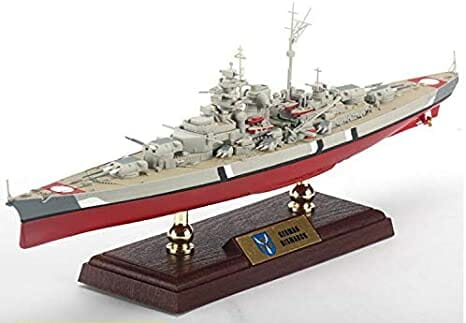Table of Contents
The Bismarck battleship model is proud to have one displayed on the shelve. This German battleship, commissioned by the Nazi regime in 1939, was one of the most powerful warships of its time. In this article, I will take you on a journey through the history of the Bismarck battleship, from its design and construction to its final moments in the North Atlantic. We will also explore the legacy of Bismarck and its influence on ship design, as well as the availability of model kits and replicas.

Introduction to the Bismarck Battleship
The Bismarck battleship was the lead ship of the Bismarck class, a pair of battleships built by Germany before and during World War II. The ship was named after Otto von Bismarck, the first Chancellor of Germany who led the country to unification in 1871. The Bismarck battleship was launched on 14 February 1939 and commissioned into the German Navy on 24 August 1940.
The Bismarck was a massive ship, measuring 251 meters in length and weighing over 50,000 tons. It was armed with eight 38-centimeter guns, twelve 15-centimeter guns, and sixteen 10.5-centimeter guns, making it one of the most heavily armed battleships of its time. The ship was also equipped with torpedo tubes and anti-aircraft guns.
Design and Construction of the Bismarck and its Sister Ship
The Bismarck battleship was designed and built by the Blohm & Voss shipyard in Hamburg, Germany. The ship was designed to be fast, heavily armored, and heavily armed. The Bismarck was also designed to be able to operate independently of other ships, thanks to its advanced radar and communication systems.
Bismarck’s sister ship, the Tirpitz, was also built by Blohm & Voss. The Tirpitz was launched on 1 April 1939 and commissioned into the German Navy on 25 February 1941. Like the Bismarck, the Tirpitz was heavily armed and armored and was designed to be able to operate independently of other ships.
The Bismarck’s First and Only Mission
Bismarck’s first and only mission was to disrupt Allied shipping in the North Atlantic. On 19 May 1941, the Bismarck and the Tirpitz left Norway and headed out into the Atlantic. The Bismarck was spotted by British aircraft on 21 May, and a large-scale naval operation was launched to hunt down and sink the ship.
The Sinking of the Bismarck – How it Happened and How Long it Took
The sinking of the Bismarck is one of the most famous naval battles of World War II. The Bismarck was engaged by the British navy on 24 May 1941, and after a fierce battle, the ship was hit by a torpedo from a British aircraft. The torpedo damaged the rudder of the Bismarck, making it impossible for the ship to steer.
The Bismarck was then attacked by a fleet of British warships, including the battleships King George V and Rodney. Bismarck fought back, but it was eventually overwhelmed by the superior firepower of the British navy. The ship sank on 27 May 1941, after taking on water and listing heavily to one side.
It took over two hours for the Bismarck to sink, and during that time, the ship was hit by hundreds of shells and torpedoes. The exact number of casualties is uncertain, but it is estimated that over 2,000 crew members died in the sinking.
The Impact of the Sinking of the Bismarck on Naval Warfare
The sinking of the Bismarck had a significant impact on naval warfare. It demonstrated the vulnerability of even the most powerful battleships to air attack, and it highlighted the importance of aircraft carriers and long-range bombers in naval warfare.
The sinking of the Bismarck also marked a turning point in the Battle of the Atlantic, as it eliminated one of Germany’s most powerful warships and disrupted their naval operations in the North Atlantic.
The Bismarck’s Legacy and Influence on Ship Design
The Bismarck battleship has had a significant influence on ship design. The ship’s advanced radar and communication systems were ahead of their time, and many of the technologies developed for the Bismarck have been used in subsequent ship designs.
Bismarck’s heavy armor and armament also had a lasting impact on ship design. Many subsequent battleships and cruisers were designed to be heavily armored and armed, in order to withstand the firepower of other battleships.
Exploring the Bismarck Battleship Today – Model Kits and Replicas
The Bismarck battleship model remains a popular subject for kit builders and naval history enthusiasts. There are many model kits and replicas available, ranging from small-scale plastic models to large-scale museum-quality replicas.
One of the most popular model kits is the Tamiya 1/350 Bismarck battleship model kit. This kit is highly detailed and accurate, and includes photo-etched parts and decals for multiple versions of the ship.
Bismarck Battleship Model Kits – 1/200 vs 1/350 Scale
When it comes to the Bismarck battleship model, there are two main scales to choose from – 1/200 and 1/350. The 1/200 scale kits Bismarck battleship model are larger and more detailed, but they are also more expensive and more difficult to build.
The 1/350 scale kits Bismarck battleship model are smaller and less detailed, but they are also more affordable and easier to build. Both scales offer a wide range of options for customization and detailing, and both are popular among model kit builders and collectors.
Conclusion – Why the Bismarck Battleship Remains a Significant Part of Naval History
The Bismarck battleship remains a significant part of naval history, due to its advanced design, impressive firepower, and the impact it had on naval warfare. The sinking of the Bismarck marked a turning point in the Battle of the Atlantic, and it demonstrated the vulnerability of even the most powerful warships to air attack.
The legacy of the Bismarck battleship lives on, in the technologies it helped develop and the subsequent ship designs it influenced. And for model-builder and naval history enthusiasts, the Bismarck battleship model remains a popular subject for study and recreation.
So, whether you are interested in naval history, ship design, or model kit building, the Bismarck battleship model is a subject worth exploring. Its history is rich and complex, and its legacy is still felt today.



